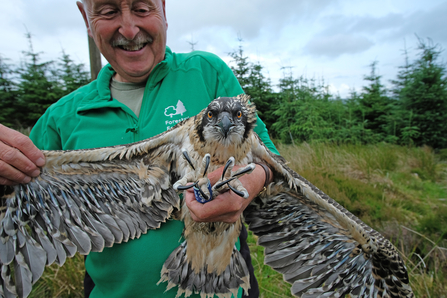
Ornithologist Martin Davison with one of the osprey chicks. Image by Forestry England.

Ornithologist Martin Davison with one of the osprey chicks. Image by Forestry England.
The magnificent bird returned to Kielder Forest as a breeding species for first time in at least 200 years in 2009.
Since then they have gone from strength-to-strength and this year eight chicks will be fitted with harmless identification rings on their legs to keep tabs on their progress.
Joanna Dailey, osprey co-ordinator with Forestry England, explained:
“This year has seen a changing of the guard with two of the older and most productive males absent, most probably dying of old age, or accident. One in particular called YA produced an astonishing 26 chicks in his life. The good news is that his first grandson – called Elsin and just two years old – has been spotted nearby and looks well placed to continue the family tradition. In total eight nests in the 63,000 acre forest were occupied this year and five of them produced heathy off-spring.”
Experts visited Nest 2 on Thursday where excellent parents have raised three chicks. Mum has now had eight chicks in just three years with two mates. Her current partner has been an attentive father, keen to help incubate eggs as well as bringing back at least two fish daily for hungry mouths.
After climbers lowered youngsters to the ground they were fitted with a unique ring on one leg and a numbered blue coloured tag on the other. This shows they were born in England and Wales. This tag can be read by people using cameras and spotting scopes meaning they can be tracked through their lives. They were also weighed and returned to the nest unharmed.
The Kielder Osprey Project is a partnership between Forestry England, Northumbrian Water, Northumberland Wildlife Trust and Wild Intrigue.
Tom Dearnley, Forestry England ecologist, added:
“The sheer scale of Kielder creates an excellent environment for rare and protected species to recover. We’ve always stressed that the success of the ospreys is good news for the wider Borders and northern England. Some of the birds will spread out and increase the likelihood this iconic species will colonise and breed elsewhere. Ospreys arrived here under their own steam, in part attracted by artificial nests erected around the forest and a reservoir well stocked with fish. What’s happened since has been a heart-warming success story.”
This year for the first time views from one of the Kielder nests has been streamed live on YouTube. To access this go to www.youtube.com/watch?v=ON4nW41NtfM The public can also enjoy the same views on large screens at Northumbrian Water's Tower Knowe visitor centre and Kielder Castle, where a live feed from a second nest is also being shown.